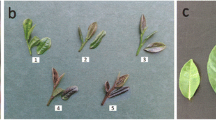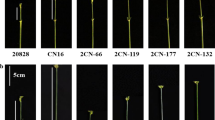Abstract
The timing of spring bud flush (TBF) in tea plants (Camellia sinensis) is an adaptive critical and economically important trait; thus, it has been a focus of many tea-breeding programs. Previously, we reported the mapping of two major and partial linked TBF QTLs onto the LG01 of C. sinensis using a full-sib population of ‘Longjing 43’ × ‘Baihaozao’. In this study, we further tested the QTL stability and expression variation in different years, experimental sites, and crossing parents. We genotyped 157 additional F1 individuals from the ‘Longjing 43’ × ‘Baihaozao’ cross and 173 F1 individuals from ‘Wuniuzao’ × ‘Longjing 43’ cross with 16 and 17 SSR markers on LG01, respectively. We also recorded the TBF trait of the two populations at Hangzhou and/or Shengzhou sites in the spring of 2014, 2015 and/or 2017. The TBF QTLs were significant (P < 0.001 at the chromosome-wide level) in all tested years, sites, and populations, but the explained phenotypic variation ranged considerable (26.2–40.5%, two QTLs were considered together in the Interval Mapping). Interestingly, the QTLs only segregated in ‘Longjing 43’ among the three parents involved. After grouping the individuals by the genotypes of the two markers closest to the QTLs, a maximum difference of 9.22 days for the average TBF was observed between the earliest and latest groups.




Similar content being viewed by others
References
Altschul SF, Madden TL, Schäffer AA, Zhang J, Zhang Z, Miller W, Lipman DJ (1997) Gapped BLAST and PSI-BLAST: a new generation of protein database search programs. Nucleic Acids Res 25:3389–3402
Beavis WB (1998) QTL analyses: power, precision, and accuracy. In: Patterson AH (ed) Molecular dissection of complex traits. CRC Press, Boca Raton
Chen L, Zhou ZX, Yang YJ (2007) Genetic improvement and breeding of tea plant (Camellia sinensis) in China: from individual selection to hybridization and molecular breeding. Euphytica 154:239–248
Collard BCY, Mackill DJ (2008) Marker-assisted selection: an approach for precision plant breeding in the twenty-first century. Philos Trans R Soc B 363:557–572
Derory J, Scotti-Saintagne C, Bertocchi E, Dantec LL, Graignic N, Jauffres A et al (2010) Contrasting relationships between the diversity of candidate genes and variation of bud burst in natural and segregating populations of European oaks. Heredity 104:438–448
Freeman JS, Potts BM, Downes GM, Pilbeam D, Thavamanikumar S, Vaillancourt RE (2013) Stability of quantitative traits loci for growth and wood properties across multiple pedigrees and environments in Eucalyptus globulus. New Phytol 198:1121–1134
Frewen BE, Chen THH, Howe GT, Davis J, Rohde A, Boerjan W, Bradshaw HD Jr (2000) Quantitative trait loci and candidate gene mapping of bud set and bud flush in Populus. Genetics 154:837–845
Gosney BJ, Potts BM, O’Reilly-Wapstra JM, Vaillancourt RE, Fitzgerald H, Davies DW, Freeman JS (2015) Genetic control of cuticular wax compounds in Eucalyptus globules. New Phytol 209:202–215
Guo JC, Ye NX, He XY (2004) Genetic variation in the leaf-expansion period of the first hybrid generation tea plants. J Tea Sci 24(4):255–259
Hao X, Yang Y, Yue C, Wang L, Horvath DP, Wang X (2017) Comprehensive transcriptome analyses reveal differential gene expression profiles of Camellia sinensis axillary buds at Para-, Endo-, ecodormancy, and bud flush stages. Front Plant Sci 8:553
He ZQ, Chen DX, Mao JX, Yong Y, Luo LM, Li S (2015) Investigation on tea pest species and fluctuation dynamics of field population quantity of severe pests in Sichuan. Southwest China J Agric Sci 28(6):2546–2551
Jermstad KD, Bassoni DL, Jech KS, Wheeler NC, Neale DB (2001) Mapping of quantitative trait loci controlling adaptive traits in coastal Douglas-fir. I. Timing of vegetative bud flush. Theor Appl Genet 102:1142–1151
Khan N, Mukhtar H (2013) Tea and health: studies in humans. Curr Pharm Des 12:6141–6147
Li HL, Lin NQ (2012) The influence of temperature and humidity on the population dynamics of small green leafhopper at tea garden. Fujian J Agric Sci 27(1):55–59
Liang YR, Shi M (2015) Advances in tea plant genetics and breeding. J Tea Sci 35:103–109
Luo YP (2015) The cultivation of tea plant. China Agriculture Press, Beijing
Ma JQ, Yao MZ, Ma CL, Wang XC, Jin JQ, Wang XM, Chen L (2014) Construction of a SSR-based genetic map and identification of QTLs for catechins content in tea plant (Camellia sinensis). PLoS ONE 9:e93131
Paul A, Kumar S (2011) Responses to winter dormancy, temperature, and plant hormones share gene networks. Funct Integr Genomics 11:659–664
Schön CC, Utz HF, Groh S, Truberg B, Openshaw S, Melchinger AE (2004) Quantitative trait locus mapping based on resampling in a vast maize testcross experiment and its relevance to quantitative genetics for complex traits. Genetics 167:485–498
Tan LQ, Wang LY, Wei K, Zhang CC, Wu LY, Qi GN, Cheng H, Zhang Q, Cui QM, Liang JB (2013) Floral transcriptome sequencing for SSR marker development and linkage map construction in the tea plant (Camellia sinensis). PLoS ONE 8(11):e81611
Tan LQ, Peng M, Xu LY, Wang LY, Chen SX, Zou Y et al (2015) Fingerprinting 128 Chinese clonal tea cultivars using SSR markers provides new insights into their pedigree relationships. Tree Genet Genomes 11:90
Tan LQ, Wang LY, Xu LY, Wu LY, Peng M, Zhang CC et al (2016) SSR-based genetic mapping and QTL analysis for timing of spring bud flush, young shoot color, and mature leaf size in tea plant (Camellia sinensis). Tree Genet Genomes 12:52
Tang H, Hao XY, Wang L, Xiao B, Wang XC, Yang YJ (2017) Molecular regulation and substance exchange dynamics at dormancy and bud break stages in overwintering buds of tea plant. Acta Agron Sin 43(5):669–677
Taniguchi F, Furukawa K, Ota-Metoku S, Yamaguchi N, Ujihara T et al (2012) Construction of a high-density reference linkage map of tea (Camellia sinensis). Breed Sci 62:263–273
Thamarus KA, Groom K, Bradley A, Raymond CA, Schileck LR, Williams ER, Moran GF (2004) Identification of quantitative trait loci for wood and fiber properties in two full-sib progenies of Eucalyptus globulus. Theor Appl Genet 190:856–864
Ukrainetz NK, Ritland K, Mansfield SD (2008) Identification of quantitative trait loci for wood quality and growth across eight full-sib coastal Douglas-fir families. Tree Genet Genomes 4:159–170
Van Ooijen JW (2004) MapQTL5, software for the mapping of quantitative trait loci in experimental populations. Kyazma BV, Wageningen
Van Ooijen JW (2006) JoinMap 4. software for the calculation of genetic linkage maps in experimental populations. Kyazma BV, Wageningen
Voorrips RE (2002) MapChart: software for the graphical presentation of linkage maps and QTLs. J Hered 93:77–78
Wang X, Yang Y, Ma C, Jin J, MaJ Cao H (2011) Cloning and expression analysis of cyclin gene (CsCYC1) of tea plant. Acta Bot Boreal Occident Sin 32(12):2365–2372
Wang X, Ma C, Yang Y, Jin J, Ma J, Cao H (2012) cDNA cloning and expression analysis of cyclin-dependent kinase (CsCDK)gene in tea plant. Acta Hortic Sin 39(2):333–342
Wang X, Hao X, Ma C, Cao H, Yue C, Wang L, Zeng J, Yang Y (2014) Identification of differential gene expression profiles between winter dormant and sprouting axillary buds in tea plant (Camellia sinensis) by suppression subtractive hybridization. Tree Genet Genomes 10:1149–1159
Xia EH, Zhang HB, Sheng J, Li K, Zhang QJ, Kim C et al (2017) The tea tree genome provides insights into tea flavor and independent evolution of caffeine biosynthesis. Mol Plant 10(6):866–877
Yang YJ, Liang YR (2014) Clonal tea cultivars in China. Shanghai Scientific and Technical Publishers, Shanghai
Yang CS, Wang X, Lu G, Picinich SC (2009) Cancer prevention by tea: animal studies, molecular mechanisms and human relevance. Nat Rev Cancer 9:429–439
Yao MZ, Ma CL, Qiao TT, Jin JQ, Chen L (2012) Diversity distribution and population structure of tea germplasms in China revealed by EST-SSR markers. Tree Genet Genomes 8:205–220
Zarpelon TG, Guimaraes LMS, Faria DA, Coutinha MM, Neto BC, Teixeira RU, Grattapaglia D, Alfenas AC (2015) Genetic mapping and validation of QTLs associated with resistance to Calonectria leaf blight caused by Calonectria pteridis in Eucalyptus. Tree Genet Genomes 11:803
Acknowledgements
This work was supported by The Earmarked Fund for Modern Agro-industry Technology Research System (nycytx-23) and Science and Technology Department of Sichuan Province (2017JY0124).
Author information
Authors and Affiliations
Corresponding authors
Ethics declarations
Conflict of interest
The authors declare no conflict of interest.
Rights and permissions
About this article
Cite this article
Tan, LQ., Peng, M., Xu, LY. et al. The validation of two major QTLs related to the timing of spring bud flush in Camellia sinensis. Euphytica 214, 17 (2018). https://doi.org/10.1007/s10681-017-2099-6
Received:
Accepted:
Published:
DOI: https://doi.org/10.1007/s10681-017-2099-6




